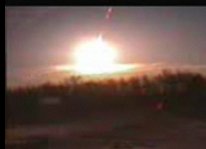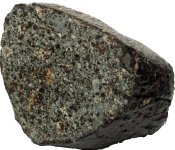
May Editorial
The Alberta-Sask meteorite

May Editorial
The Alberta-Sask meteorite
|
On the 10th of November 2008, residents of northern Alberta witnessed a large fireball heading through the atmosphere on its way to earth. The meteorite, which scientists believe split into three parts on its journey through the atmosphere, hit the ground around Buzzard Coulee, just short of the border between the provinces of Alberta and Saskatchewan in Canada. The meteoroid's descent was captured on the video which you can see by following the link give below.
|
Fortunately, no-one was injured by the meteor as it landed on empty fields. As the meteorite hit the earth it shattered into thousands of pieces which were scattered over a wide area. The biggest piece recovered so far weighs 13 kg. A research team from the University of Calgary has been sent on a recovery mission to collect as many pieces of this meteor as possible. The team are accompanied by a local volunteers and meteorite hunters. In total over 1000 pieces have been recovered. The meteorite-hunting team announced on the 4th of May 2009 that the event has already yielded the most meteorites ever recovered from a single meteor fall. The previous record had been 700, set in 1960 by a meteor that hit the ground in central Alberta. | |
|
Dr. Alan Hildebrand, who leads the recovery team, believes that they have just scratched the surface when it comes to the recovery. As mentioned, he believes that many more pieces remain to be found with some of the biggest treasures still undiscovered. 
Dr Hildebrand also gave an clue as to what is believed to be the origin of the meteorite. The early indications point to the meteorite as being made from rock about 4½ billion years old whichare classified as a type called H4. Meteorites are classified into three major groups: stony, iron and stony-iron meteorites. Within each group there are number of subgroups. H meteorites are a subgroup of the orginary chondrites which in turns belong to the stony meteorite group. The H stands for (H)igh iron abundance, with respect to other ordinary chondrites, the iron content being about 25-31% by weight. H type ordinary chondrites are the most common type of meteorite, accounting for approximately 40% of all those catalogued, 46% of the ordinary chondrites, and 44% of the chondrites. Prominent among the components present in chondrites are the enigmatic chondrules, millimeter-sized objects that originated as freely floating, molten or partially molten droplets in space; most chondrules are rich in the silicate minerals olivine and pyroxene. Ordinary H chondrites, also referred to as olivine-bronzite chondrites are further grouped by the numbers 3-7, indicating the amount of change or metamorphism in the chondrules. The Alberta-Sask meteorite can be seen as it plunges to the ground on this short movie. | |
| _______________________________ | ||||
| Home | | | Shopping | | | Database |
© Biscuit Software 2004-2015
All rights reserved